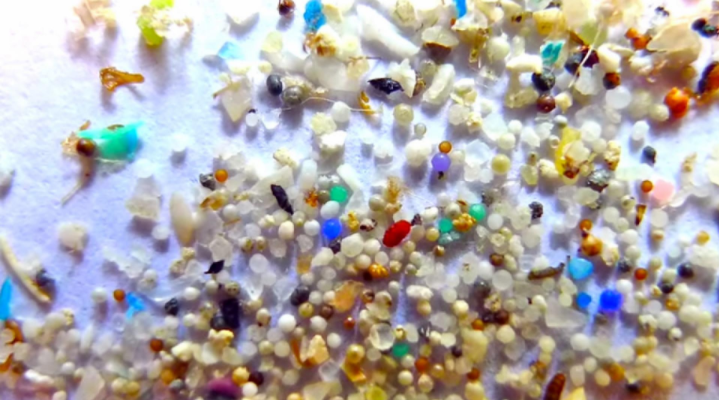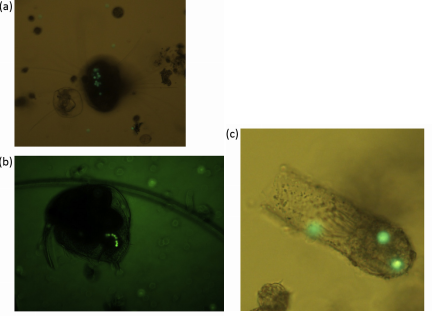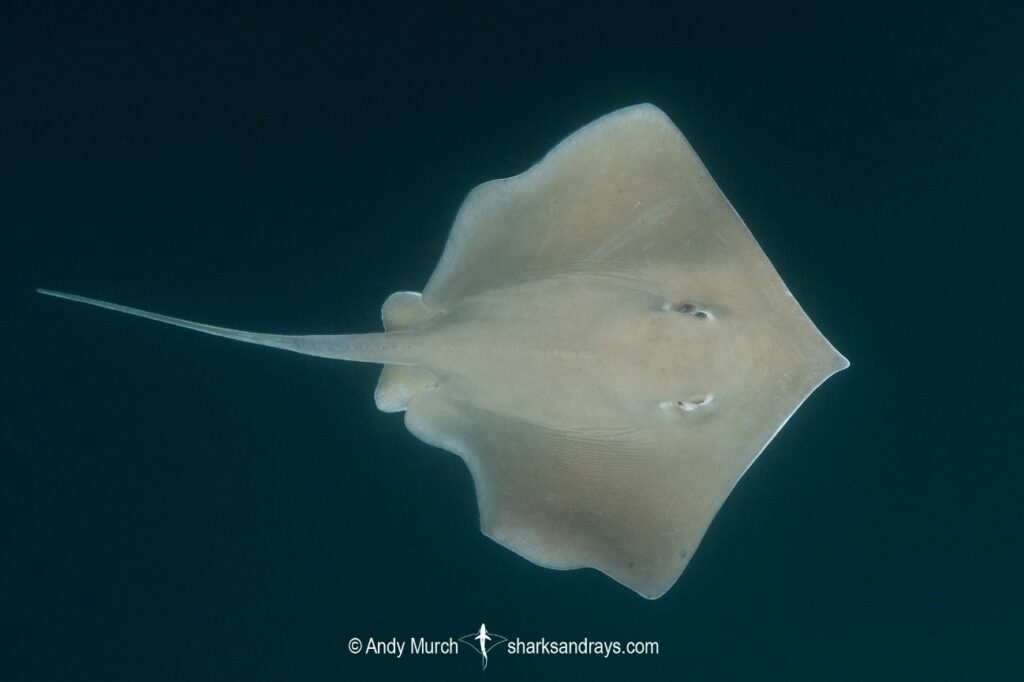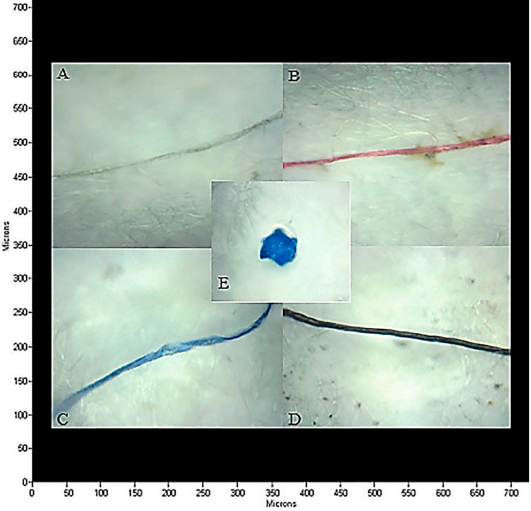Microplastics (MPs) are plastic particles with maximum dimensions of 5 mm. This material is distributed on a large scale in environments, reaching more remote areas of the ocean and entering the food chain of many organisms on a global scale.

Figure 1: The various shapes and sizes of plastic microspheres. Source: 5Gyres
The plastic resins global production reaches around 300 million metric tons per year. These materials showed an increase in annual production of 8.7% between 1950 and 2012. PE (polyethylene) and PP (polypropylene) are the most abundant thermoplastic resins among the MPs collected in the oceans and coastal regions.
Microplastics can be of primary or secondary origin. Primary PMs are produced industrially, as an example of microspheres. Microspheres are used in personal care products like scrubs, toothpaste, and soaps, or they can be used to give texture to a certain material. However, microspheres can absorb toxins from the environment they are, such as pesticides and pollutants. After ingestion of this microplastic by an organism, the absorbed toxins can be released to it.
MPs of secondary origin are the most abundant microplastics in the environment. They are the result of the use and climatic degradation (sun, rain, waves) of larger plastic materials dumped in coastal environments and the ocean. In beach ecosystems, for example, climate degradation is responsible for the largest source of secondary MPs.
Most MPs are found in coastal regions close to population centers, with an estimated 270 billion metric tons of microplastic in these areas. MPs consumed by plankton are not included in this estimate.
Phytoplankton is very important for the marine food chain since they are the base organisms. The absorption of microplastic by phytoplankton reduces its capacity for photosynthesis and creates stress in this organism, which cannot expel microplastics from its body. The decrease in photosynthesis and the number of organisms in the environment can cause the reduction of all other following organisms.

Figure 2: Particles of fluorescent microplastic ingested by 3 distinct species of zooplankton (a) Marenzelleria spp., (B) Bosmina coregoni maritima, (c) Tintinnopsis lobiancoi. Source: Setälä, O., Fleming-Lehtinen, V., & Lehtiniemi, M., 2014.
The concern about plastic waste in the oceans has become increasingly significant over the years, especially due to the ingestion of plastic by organisms. In the Maranhão estuarine complex, on the Amazon coast, plastics fragments ingested by Hypanus guttatus, known as a Longnose stingray or garbage ray, were found.

Figure 3: Longnose stingray example. Source: Andy Murch.
During the ingested substances analysis, it was possible to identify significant levels of MPs present in the Longnose stingray. The species is an important predator of coastal benthic and benthopelagic organisms. As a top predator, these organisms are susceptible to accumulating microplastics through the food chain by passive ingestion, which is the act of consuming an organism that already had microplastics in its body.
In its stomach, it was possible to identify that, of the ingested plastic, 82% were fibers and the other 18% were fragments mainly blue (47%) or transparent (35.3%), and in smaller portions, black (11.8%) and red (5.9%).

Figure 4: Three distinct categories of the microplastic present in the stomach of the Longnose stingray, Hypannus guttatus, collected in the Maranhão gulf, being: (A) transparent fiber, (B) red fiber, (C) blue fiber, (D) black fiber, ( E) blue fragment. Source: Egado et al. (2021)
Six types of PM polymers have also been found in stingrays. The most abundant polymer was PET (polyethylene terephthalate), widely used in textile production, such as clothes and sheets. PET is a type of microplastic common in domestic sewage and, because it is a dense polymer, it precipitates to the bottom of aquatic environments and can be ingested by benthic organisms. Two other polymers were also observed in the rays: PE and PA, which may have their origin associated with the fishing material.
The use and disposal of plastic products is an alarming topic. Several countries such as the United Kingdom, France, the USA, and Japan have already adopted measures to ban or reduce the use of these compounds. Companies like Dove, Unilever, Nestlé, Tramontina, and others, work to reduce the use of plastics in general or adopt the use of recycled plastics. Regarding plastic microspheres, one of the best solutions is not to use. There are several organic or natural materials that can replace and have the same function as plastic microspheres, such as products with sugar, coffee granules, oats, or volcanic minerals.
Below we have the video from NOAA explaining microplastics:
Source: National Oceanic and Atmospheric Administration, https://oceanservice.noaa.gov/facts/microplastics.html
References
Anagnosti, L., Varvaresou, A., Pavlou, P., Protopapa, E., & Carayanni, V., 2021. Worldwide actions against plastic pollution from microbeads and microplastics in cosmetics focusing on European policies. Has the issue been handled effectively?. Marine Pollution Bulletin, 162, 111883. https://www.sciencedirect.com/science/article/abs/pii/S0269749113005411
Andrady, A. L., 2014. The plastic in microplastics: A review. Marine Pollution Bulletin 119 (2017) 12–22. https://doi.org/10.1016/j.marpolbul.2017.01.082
Anderson, A., Baker, J. E., Andrady, A. L., Bouwman H., 2015. Sources, fate, and effects of microplastics in the marine environment: a global assessment. Rep. Stud. GESAMP No. 90, 96 p. https://ec.europa.eu/environment/marine/good-environmental-status/descriptor-10/pdf/GESAMP_microplastics%20full%20study.pdf
Covernton, G. A., Cox, K. 2019. Commentary on: Abundance and distribution of microplastics within surface sediments of a key shellfish growing region of Canada, Plos One 14(12): e0225945. https://doi.org/10.1371/journal.pone.0225945
Egado, T., Brabo, L., Schmid, K., Sarti, F., Gava, T. T., Nunes, J., Chelazzi, D., Cincinelli, A., Giarrizzo, T. Ingestion of microplastics by Hypanus guttatus stingrays in the Western Atlantic Ocean (Brazilian Amazon Coast). Marine Pollution Bulletin, 162, 111799. 2021. https://doi.org/10.1016/j.marpolbul.2020.111799
Gazulha. V, O efeito do microplástico no zooplâncton marinho. Disponível em: www.vgconsultoriaambiental.com.br/o-efeito-dos-microplasticos-no-zooplancton-marinho/.
Setälä, O., Fleming-Lehtinen, V., & Lehtiniemi, M. Ingestion and transfer of microplastics in the planktonic food web. Environmental Pollution, 185, 77–83, 2014. https://www.sciencedirect.com/science/article/abs/pii/S0269749113005411
Empresas que lutam contra o plástico: https://www.consumidormoderno.com.br/2019/10/24/13-iniciativas-de-grandes-empresas-na-luta-contra-o-uso-de-plastico/
Materiais que podem substituir as microesferas plásticas: https://redandhoney.com/replace-microbeads-natural-exfoliatiors/
